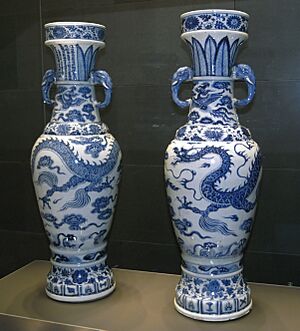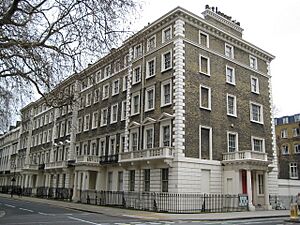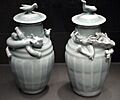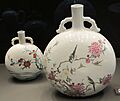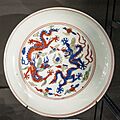Percival David Foundation of Chinese Art facts for kids
The Percival David Foundation of Chinese Art (often called the PDF) is a special collection of Chinese pottery and other related items. This amazing collection was put together by a man named Percival David. Today, you can see these treasures on display in a special room (Room 95) at the British Museum in London.
The main goal of the Percival David Foundation is to help people learn more about Chinese art and culture. The collection has about 1,700 pieces. Most of these are beautiful porcelain items from the 10th to the 18th centuries, covering the Song, Yuan, Ming, and Qing periods. It also includes a painting called Scroll of Antiquities from 1728.
This collection focuses on pottery made for Chinese people, especially for the emperors, rather than items made for export to other countries. Many pieces come from Jingdezhen ware, a famous pottery center. You can find rare types of pottery like Ru ware and Guan ware. Two very important pieces are the "David Vases" from the Yuan dynasty (1351). These are the oldest dated blue and white porcelain items known! The Foundation also has a large library of books about Chinese art, which is now kept at the School of Oriental and African Studies (SOAS) library.
Sir Percival David gave his collection to the University of London in 1950. For many years, it was displayed in a house at 53 Gordon Square and was used to teach students about Chinese art. Since 2009, the collection has been on show in a special gallery at the British Museum.
Contents
How the Collection Started
Percival David began collecting Chinese art around 1913 and continued until he passed away in 1964. He first visited China in 1923 and fell in love with Chinese pottery. In 1925, he helped organize an exhibition of many amazing items from the imperial collection in the Forbidden City in Beijing.
In 1927, he bought some items that originally came from the Forbidden City. These pieces had been sold off by people working for the emperor during the late Qing dynasty. It's even said that Empress Dowager Cixi used some of these items as loan collateral. David managed to buy about 40 pieces and bring them to the United Kingdom. He returned to China in 1930 to help with more exhibitions and create catalogs of the pottery.
We don't know exactly how David acquired every piece, but he likely bought many from dealers, auctions, and other collectors. For example, the famous Yuan dynasty 'David Vases' came from two different places. Many pieces in the collection were once owned by the Qing dynasty emperors, and some even have notes added by the Qianlong Emperor (who ruled from 1736–95). Percival David's collection is considered the most important collection of Chinese ceramics outside of China and Taiwan.
Moving the Collection
In 1931, David's collection was shown at the Dorchester Hotel in London. During World War II, it was moved to the countryside to keep it safe. Percival David also created a special teaching position (called a Chair) for Chinese Art and Architecture at the Courtauld Institute of Art, which is part of the University of London.
Towards the end of his life, David wanted to make sure his entire collection stayed together. He worked with the University of London, and they agreed to keep the collection and its library together as a foundation linked to SOAS. The special teaching position he created also moved to SOAS. The collection opened to the public on June 10, 1952, at 53 Gordon Square, Bloomsbury.
The foundation has loaned many of its pieces to other countries. For example, many Yuan dynasty porcelain items were sent to Venice to celebrate 700 years since Marco Polo's journey. Other items have traveled as far as Japan and the United States. The library collection was a working library for researchers and is now available through SOAS.
A New Home at the British Museum
Due to money problems, the building at 53 Gordon Square closed at the end of 2007. The entire ceramics collection, about 1,700 objects, is now on a long-term loan to the British Museum. It is on permanent display in a specially designed gallery, Room 95, which opened on April 23, 2009. This move was supported by Sir Joseph Hotung. The public gallery is part of the Sir Joseph Hotung Centre for Ceramic Studies, which also has facilities for teaching using the collection.
A book called Chinese Ceramics: Highlights of the Sir Percival David Collection was published in April 2009 to celebrate the opening of the new display.
What's in the Collection?
Percival David focused his collection on Chinese ceramics like stoneware and porcelain from the 10th to the 18th centuries (Song to Qing dynasties). There are also a few older pieces from the Six Dynasties and Tang periods. The oldest item is from the third-century Western Jin.
David chose not to collect Chinese earthenware because similar pottery developed all over the world. His goal was to show the unique development of ceramics in China. He picked pieces based on their excellent craftsmanship and historical importance, always thinking about how they could be used for education. Many items were imperial wares made for the emperors of the Ming and Qing dynasties. He also collected an unusual number of the rare Song dynasty Ru ware pieces. Just before the collection opened in 1952, it also received a small collection of mostly plain porcelain from Mountstuart Elphinstone.
At the British Museum, the 1,700 items begin with the famous David Vases placed before the main part of Room 95. About 200 of the very best pieces are shown in special cases in the middle of the room. The remaining 1,500 pieces are arranged more closely together on glass shelves around the room.
Images for kids
-
Case with over 5% of the world's surviving Ru ware, Song, around 1100
-
Wucai dish with dragons chasing flaming pearls, Ming, Longqing mark and period, 1567–1572, PDF 798
-
Xing ware from the Tang dynasty
-
Chicken cup in doucai
-
Snuff bottle, painted porcelain, Qianlong period


